Hydrothermal Carbonate Mineralization, Calcretization, and Microbial Diagenesis Associated with Multiple Sedimentary Phases in the Upper Cretaceous Bekhme Formation, Kurdistan Region-Iraq
Abstract
:1. Introduction
2. Geological Setting
3. Sampling and Methods
4. Results
4.1. Field Observations
4.2. Petrography and Diagenesis
4.2.1. Reefal Boundstone and Bioclastic Packstone Facies or “Original Limestone”
4.2.2. Chertification and Replacive Silica
4.2.3. Replacement Dolomite (DI)
4.2.4. Medium-Coarse Crystalline Dolomite (DII)
4.2.5. Transparent Dolomite (DIII)
4.2.6. Saccharoidal Dolomite (Ds)
4.2.7. Medium-Sized Saddle Dolomite (SD1)
4.2.8. Dirty and Milky Saddle Dolomites (SD2 and SD3)
4.2.9. White Calcite CI and Transparent Calcite CII
4.3. Degrading Mechanism and Sparmicritization in Calcrete
4.4. Petrography of the Calcrete Level
4.4.1. Type 1: Alveolar Horizon
4.4.2. Type 2: Pisolitic and Laminar Horizons
4.4.3. Types 3: Transitional Horizon
4.4.4. Type 4: Chalky Textures
4.5. Microfacies of the Paleo-Channel
4.5.1. Microfacies 1: Microbial Bindstone
4.5.2. Microfacies 2: Bioclastic Peloidal Packstone/Grainstone
4.5.3. Microfacies 3: Intraclastic Peloidal Grainstone and Mudstone
4.6. Microbial Diagenesis
4.6.1. Microbial Forms
i. Fungi
ii. Algal Forms
4.6.2. Bacterial Forms
4.6.3. Dissolution
4.6.4. Micritization and De-Micritization
4.6.5. Cementation
4.6.6. Replacement
4.6.7. Grain-to-Grain and Wall Bridging
4.6.8. Open-Space Filling, Porosity, Permeability, and Grains Size
4.7. O–C Isotopes
5. Discussion and Interpretation
5.1. Origin of Geodes/Fracture-Filling Carbonate Minerals and Origin of Calcrete
5.2. Time and Duration of Calcrete Exposure: A Response to Sea-Level Fluctuation and Tectonics
5.3. Tidal and Channel Signals in the Bekhme Formation
6. Conclusions
Author Contributions
Funding
Conflicts of Interest
References
- Biehl, L.R.B.C.; Kukla, P.A. Impacts of hydrothermal dolomitization and thermochemical sulfate reduction on secondary porosity creation in deeply buried carbonates: A case study from the Lower Saxony Basin, northwest Germany. AAPG Bull. 2016, 100, 597–621. [Google Scholar] [CrossRef]
- Nader, F.; López-Horgue, M.; Shah, M.; Dewit, J.; Garcia, D.; Swennen, R.; Iriarte, E.; Muchez, P.; Caline, B. The Ranero Hydrothermal Dolomites (Albian, Karrantza Valley, Northwest Spain): Implications on Conceptual Dolomite Models. Oil Gas Sci. Technol. Rev. d’IFP Energ. Nouv. 2012, 67, 9–29. [Google Scholar] [CrossRef] [Green Version]
- Wilson, N.S.F.; Stasiuk, L.D.; Fowler, M.G. Origin of organic matter in the Proterozoic Athabasca Basin of Saskatchewan and Alberta, and significance to unconformity uranium deposits. Bull. Geol. Surv. Can. 2007, 588, 325–339. [Google Scholar]
- Davies, G.R.; Smith, L.B. Structurally controlled hydrothermal dolomite reservoir facies: An overview. AAPG Bull. 2006, 90, 1641–1690. [Google Scholar] [CrossRef]
- Conliffe, J.; Burden, E.T.; Wilton, D.H.C. The Use of Integrated Fluid Inclusion Studies for Constraining Petroleum Charge History at Parsons Pond, Western Newfoundland, Canada. Minerals 2017, 7, 39. [Google Scholar] [CrossRef]
- Wright, V.P. Paleosols in shallow marine carbonate sequences. Earth Sci. Rev. 1994, 35, 367–395. [Google Scholar] [CrossRef]
- Blatt, H.; Middlenton, V.; Murry, R. Origin of Sedimentary Rocks, 2nd ed.; Prentice-Hall Inc.: Englewood Cliffs, NJ, USA, 1980; p. 634. [Google Scholar]
- Cantarero, I.; Travé, A.; Baqués, V. Polyphasic hydrothermal and meteoric fluid regimes during the growth of a segmented fault involving crystalline and carbonate rocks (Barcelona Plain, NE Spain). Geofluids 2014, 14, 20–44. [Google Scholar] [CrossRef]
- English, J.M.; Lunn, G.A.; Ferreira, L.; Yacu, G. Geologic evolution of the Iraqi Zagros, and its influence on the distribution of hydrocarbons in the Kurdistan region. AAPG Bull. 2015, 99, 231–272. [Google Scholar] [CrossRef]
- Dunnington, H.V.; Wetzel, R.; Morton, D.M. Lexique stratigraphique international Asie. Fasc. Iraq. Paris 1959, 10, 333. [Google Scholar]
- Mansurbeg, H.; Morad, D.; Othmana, R.; Morad, S.; Ceriani, A.; Al-Aasm, I.; Kolo, K.; Spirov, P.; Proust, J.; Préat, P.; et al. Hydrothermal dolomitization of the Bekhme formation (Upper Cretaceous), Zagros Basin, Kurdistan Region of Iraq: Record of oil migration and degradation. Sediment. Geol. 2016, 341, 147–162. [Google Scholar] [CrossRef]
- Ballato, P.; Uba, C.; Landgraf, A.; Strecker, M.; Sudo, M.; Stockli, D.; Friedrich, A.; Tabatabaei, S. Arabia-Eurasia continental collision: Insights from late Tertiary foreland basin evolution in the Alborz Mountains, northern Iran. Geol. Soc. Am. Bull. 2011, 123, 106–131. [Google Scholar] [CrossRef]
- Ismail, S.; Kettanah, Y.; Chalabi, S.; Ahmed, A.; Arai, S. Petrogenesis and PGE distribution in the Al-and Cr-rich chromites of the Qalander ophiolite, northeastern Iraq: Implications for the tectonic environment of the Iraqi Zagros Suture Zone. Lithos 2014, 202, 21–36. [Google Scholar] [CrossRef]
- Omar, A. An Integrated Structural and Tectonic Study of the Binabawi-Safin-Bradost Region in Iraqi Kurdistan. Ph.D. Thesis, University of Salahaddin, Erbil, Iraq, 2005. [Google Scholar]
- Omar, A.A.; Syan, S.H. Construction of a Structural Model for Harir Anticline within Zagros Fold-Thrust belt, Kurdistan of Iraq. Zanco J. Pure Appl. Sci. 2016, 28, 90–105. [Google Scholar]
- László, C.; Ágoston, S.; Tamás, P.; László, K.; Salae, A.T.; Athar, A. Structural evolution of the northwestern Zagros, Kurdistan Region, Iraq: Implications on oil migration. GeoArabia 2012, 17, 81–116. [Google Scholar]
- Tessier, B. Upper intertidal rhythmites in the Mont-Saint-Michel Bay (NW France): Perspectives for paleoreconstruction. Mar. Geol. 1993, 110, 355–367. [Google Scholar] [CrossRef]
- Greb, S.; Archer, A. Rhythmic sedimentation in a mixed tide and wave deposit, Hazel Patch sandstone (Pennsylvanian), eastern Kentucky coal field. J. Sediment. Res. 1995, 65, 96–106. [Google Scholar]
- Archer, D.; Martin, P.; Buffett, B.; Brovkin, V.; Rahmstorf, S.; Ganopolski, A. The importance of ocean temperature to global biogeochemistry. Earth Planet. Sci. Lett. 2004, 222, 333–348. [Google Scholar] [CrossRef]
- Yocum, D.A.; De Wet, C.B.; Mora, C.I. Carbonate Lakes in Closed Basins: Sensitive Indicators of Climate and Tectonics: An Example From the Gettysburg Basin (Triassic), Pennsylvania, USA. In Relative Role of Eustasy, Climate, and Tectonism in Continental Rocks; SEPM-Society for Sedimentary Geology: Tulsa, OK, USA, 1998; Volume 59, pp. 191–209. [Google Scholar]
- Alonso-Zarza, A.M. Initial stages of laminar calcrete formation by roots: Examples from the Neogene of central Spain. Sediment. Geol. 1999, 126, 177–191. [Google Scholar] [CrossRef]
- Tanner, L.; Lucas, S.G. Calcareous paleosols of the Upper Triassic Chinle Group, Four Corner region, southwestern United States. In Paleoenvironmental Record and Applications of Calcretes and Palustrine Carbonates; Alonso-Zarza, A.M., Tanner, L.H., Eds.; Special Paper; Geological Society of America: Pod, CO, USA, 2006; Volume 416, pp. 53–74. [Google Scholar]
- Salih, N.; Mansurbeg, H.; Kolo1, K.; Gerdes, A.; Préat, A. In situ U-Pb dating of hydrothermal diagenesis in tectonically controlled fracturing in the Upper Cretaceous Bekhme Formation, Kurdistan Region-Iraq. Int. Geol. Rev. 2019, in press. [Google Scholar]
- Brusca, C.; Dessau, G. I giacimenti piombo-zinciferi diS.Giovanni (Iglesias) nel quadro della geologia del Cambricosardo. Ind. Min. 1968, 19, 470–494. [Google Scholar]
- Watts, N.L. Quaternary pedogenic calcretes from the Kalahari (southern Africa): Mineralogy, genesis and diagenesis. Sedimentology 1980, 27, 661–686. [Google Scholar] [CrossRef]
- Goudie, A.S. Calcrete. In Chemical Sediments and Geomorphology; Goudie, A.S., Pye, K., Eds.; Academic Press: London, UK, 1983; pp. 93–131. [Google Scholar]
- Wright, V.; Tucker, M. Calcretes: An introduction. In Calcretes. International Association of Sedimentologists; Wright, V.P., Tucker, M.E., Eds.; Reprint Series 2; Blackwell Scientific Publications: Oxford, UK, 1991; p. 352. [Google Scholar]
- Milnes, A. Calcrete. Development in Earth Surface Processes. In Weathering, Soils and Paleosol; Martini, I.P., Chesworth, W., Eds.; Elsevier: Amsterdam, The Netherlands, 1992; Volume 2, pp. 309–347. [Google Scholar]
- Kahle, C.F. Origin of subaerial Holocene calcareous crusts: Role of algae, fungi and sparmicritisation. Sedimentology 1977, 24, 413–435. [Google Scholar] [CrossRef]
- Adams, A. Calcrete profiles in the Eyam Limestone (Carboniferous) of Derbyshire: Petrology and regional significance. Sedimentology 1980, 27, 651–711. [Google Scholar] [CrossRef]
- Wright, V.P.; Platt, N.H.; Wimbledon, W.A. Biogenic laminar calcretes: Evidence of calcified root-mat horizons in paleosols. Sedimentology 1988, 35, 603–620. [Google Scholar] [CrossRef]
- Fu, Q.; Qing, H.; Bergman, K.M. Dolomitized calcrete in the Middle Devonian Winnipegosis carbonate mounds, subsurface of south–central Saskatchewan, Canada. Sediment. Geol. 2004, 168, 49–69. [Google Scholar] [CrossRef]
- Denver, L.E. Paleoenvironmental Significance of Lower Permian, Low-Relief, Cryptalgal Deposits of the Midcontinent. Master’s Thesis, University of Kansas, Lawrence, KS, USA, 1985. [Google Scholar]
- Kolo, K.; Mamet, B.; Préat, A. Dichotomous filamentous dolomite crystal growth in the Lower Carboniferous from Northern France: A possible direct production of fungal activity? In Proceedings of the First Geologica Belgica International Meeting, Leuven, Belgium, 11–15 September 2002; pp. 121–123. [Google Scholar]
- Gadd, G.M. Geomycology: Biogeochemical transformations of rocks, minerals, metals and radionuclides by fungi, bioweathering and bioremediation. Mycol. Res. 2007, 111, 3–49. [Google Scholar] [CrossRef]
- Gadd, M.G.; Layton-Matthews, D.; Peter, J.M.; Paradis, S. In situ trace element and sulphur isotope analyses of pyrite constrain timing of mineralization and sources of sulphur in the Howard’s Pass SEDEX Zn-Pb District, Yukon. In Targeted Geoscience Initiative 4: Sediment-Hosted Zn-Pb Deposits: Processes and Implications for Exploration; Paradis, S., Ed.; Geological Survey of Canada: Ottawa, ON, Canada, 2015; pp. 58–74. [Google Scholar]
- Peter, J.M.; Gadd, M.G.; Layton-Matthews, D. Non-hydrothermal origin of apatite in SEDEX mineralization and host rocks of the Howard’s Pass district, Yukon, Canada. Am. Miner. 2016, 101, 1061–1071. [Google Scholar]
- Kolo, K.; Konhauser, K.; Prian, J.P.; Préat, A. Probable fungal colonization andcarbonate diagenesis of Neoproterozoic stromatolites from South Gabon, Western Congo Basin. Basin. In The Geology and Resource Potential of the Congo Basin; de Wit, M.J., Guillocheau, F., de Wit, M.C.J., Eds.; Springer: Berlin/Heidelberg, Germany, 2015. [Google Scholar]
- Bindschedler, S.; Cailleau, G.; Verrecchia, E. Role of Fungi in the Biomineralization of Calcite. Minerals 2016, 6, 41. [Google Scholar] [CrossRef]
- Sánchez-Román, M.; Vasconcelos, C.; Schmid, T.; Dittrich, M.; McKenzie, J.A.; Zenobi, R.; Rivadeneyra, M.A. Aerobic microbial dolomite at the nanometer scale: Implications for the geologic record. Geology 2008, 36, 879–882. [Google Scholar] [CrossRef]
- Armenteros, M.; Aristoy, M.C.; Barat, J.M.; Toldrá, F. Biochemical and sensory changes in dry cured ham salted with partial replacement of sodium by a mixture of potassium, calcium and magnesium. Meat Sci. 2012, 90, 361–367. [Google Scholar] [CrossRef]
- Kolo, K.; Keppens, E.; Préat, A.; Claeys, P. Experimental observations on fungal diagenesis of carbonate substrates. J. Geophys. Res. Space Phys. 2007, 112. [Google Scholar] [CrossRef] [Green Version]
- Verrecchia, P. Fungi and sediments. In Microbial Sediments; Riding, R.E., Awramik, S.M., Eds.; Springer: Berlin/Heidelberg, Germany, 2000; pp. 69–75. [Google Scholar]
- Anbu, P.; Kang, C.H.; Shin, Y.J.; So, J.S. Formations of calcium carbonate minerals by bacteria and its multiple applications. SpringerPlus 2016, 5, 250. [Google Scholar] [CrossRef]
- Riding, R. Bacterial Biomineralization. In Fundamentals of Geobiology; Knoll, A.H., Canfield, D.E., Konhauser, K.O., Eds.; Wiley: Hoboken, NJ, USA, 2012; pp. 105–130. [Google Scholar]
- Gradstein, M.; Ogg, J.G.; Schmitz, M.; Ogg, G. (Eds.) The Geologic Time Scale; Elsevier: Amsterdam, The Netherlands, 2012; p. 1176. [Google Scholar]
- Veizer, J.; Hoefs, J. The nature of O18/O16 and C13/C12 secular trends in sedimentary carbonate rocks. Geochim. Cosmochim. Acta 1976, 40, 1387–1395. [Google Scholar] [CrossRef]
- Pearson, P.N.; Ditchfield, P.W.; Singano, J.; Harcourt-Brown, K.G.; Nicholas, C.J.; Olsson, R.K.; Shackleton, N.J.; Hall, M.A. Warm tropical sea surface temperatures in the Late Cretaceous and Eocene epochs. Nature 2001, 413, 481–487. [Google Scholar] [CrossRef]
- Radke, B.; Mathis, R. On the formation and occurrence of saddle dolomite. J. Sediment. Res. 1980, 50, 1149–1168. [Google Scholar]
- Searl, A. Saddle dolomite: A new view of its nature and origin. Miner. Mag. 1989, 53, 547–555. [Google Scholar] [CrossRef]
- Lohmann, C. Geochemical patterns of meteoric diagenetic systems and their application to studies of paleokarst. In Paleokarst; James, N.P., Choquette, P.W., Eds.; Springer: New York, NY, USA, 1988; pp. 58–80. [Google Scholar]
- Longhitano, S.G.; Mellere, D.; Steel, R.J.; Ainsworth, R.B. Tidal depositional systems in the rock record: A review and new insights. Sediment. Geol. 2012, 279, 2–22. [Google Scholar] [CrossRef]
- Salih, N.; Kamal, I.; Préat, A. Classical observations and stable isotopes for identification the diagenesis of Jeribe formation at Jambour oil Fields-Kurdistan Region-Iraq. Pet. Sci. Technol. 2019, 37, 1548–1556. [Google Scholar] [CrossRef]
- Osborne, M.J.; Swarbrick, R.E. Mechanisms for Generating Overpressure in Sedimentary Basins: A Reevaluation. AAPG Bull. 1997, 81, 1023–1041. [Google Scholar]
- Boni, M.; Parente, G.; Bechstädt, T.; De Vivo, B.; Iannace, A. Hydrothermal dolomites in SW Sardinia (Italy): Evidence for a widespread late-Variscan fluid flow event. Sediment. Geol. 2000, 131, 181–200. [Google Scholar] [CrossRef]
- Wendte, J.; Chi, G.; Al-Aasm, I.; Sargent, D. Fault/fracture controlled hydrothermal dolomitization and associated diagenesis of the Upper Devonian Jean Marie Member (Redknife Formation) in the July Lake area of northeastern British Columbia. Bull. Can. Pet. Geol. 2009, 57, 275–322. [Google Scholar] [CrossRef]
- Shah, M.; Nader, F.; Dewit, J.; Swennen, R.; Garcia, D. Fault-related hydrothermal dolomites in Cretaceous carbonates (Cantabria, northern Spain): Results of petrographic, geochemical and petrophysical studies. Bull. Soc. Geol. Fr. 2010, 181, 391–407. [Google Scholar] [CrossRef]
- Diehl, S.; Hofstra, A.; Koenig, A.; Emsbo, P.; Christiansen, W.; Johnson, C. Hydrothermal Zebra Dolomite in the Great Basin, Nevada—Attributes and Relation to Paleozoic Stratigraphy, Tectonics, and Ore Deposits. Geosphere 2010, 6, 663–690. [Google Scholar] [CrossRef]
- Luczaj, J.; Harrison, W., III; Williams, N. Fractured hydrothermal dolomite reservoirs in the Devonian Dundee Formation of the central Michigan Basin. Am. Assoc. Pet. Geol. Bull. 2006, 90, 1787–1801. [Google Scholar] [CrossRef] [Green Version]
- Dana, E. A Textbook of Mineralogy; John Wiley and Sons: Hoboken, NJ, USA, 1955; p. 851. [Google Scholar]
- Klappa, C. Lichen stromatolites: Criterion for subaerial exposure and a mechanism for the formation of laminar calcrete (caliche). J. Sediment. Petrol. 1979, 49, 387–400. [Google Scholar]
- Wright, V. Terrestrial stromatolites and laminar calcretes: A review. Sediment. Geol. 1989, 65, 1–13. [Google Scholar] [CrossRef]
- Driese, S.G.; Srinivasan, K.; Mora, C.I.; Stapor, F.W. Paleoweathering of Mississippian Monteagle Limestone preceding development of a lower Chesterian transgressive systems tract and sequence boundary, middle Tennessee and northern Alabama. GSA Bull. 1994, 106, 866–878. [Google Scholar] [CrossRef]
- Webb, G.E. Paleokarst, paleosol, and rocky-shore deposits at the Mississippian-Pennsylvanian unconformity, northwestern Arkansas. GSA Bull. 1994, 106, 634–648. [Google Scholar] [CrossRef]
- Wright, V. A micromorphological classification of fossil and recent calcic and petrocalcic structures. In Soil Micromorphology: A Basic and Applied Science; Douglas, L.A., Ed.; Development in Soil Science; Elsevier: Amsterdam, The Netherlands, 1990; Volume 19, pp. 401–407. [Google Scholar]
- Alonso-Zarza, A.M. Palaeoenvironmental significance of palustrine carbonates and calcretes in the geological record. Earth Sci. Rev. 2003, 60, 261–298. [Google Scholar] [CrossRef] [Green Version]
- Alonso-Zarza, M.; Tanner, H. Carbonates in Continental Setting: Facies, Environments and Processes; Developments in Sedimentology; Elsevier: Amsterdam, The Netherlands, 2010; pp. 225–267. [Google Scholar]
- Esteban, M.; Klappa, C.F. Subaerial exposure environments. In Carbonate Depositional Environments; Scholle, P.A., Bebout, D.G., Moore, C.H., Eds.; American Association Petroleum Geologists Memoir; American Association Petroleum Geologists: Tulsa, OK, USA, 1983. [Google Scholar]
- Verrecchia, E.; Verrecchia, K. Needle-fiber calcite: A critical review and a proposed classification. J. Sediment. Res. 1994, 64, 650–664. [Google Scholar]
- Harrison, R.S.; Steinen, R.P. Subaerial crusts, caliche profiles, and breccia horizons: Comparison of some Holocene and Mississippian exposure surfaces, Barbados and Kentucky. GSA Bull. 1978, 89, 385–396. [Google Scholar] [CrossRef]
- Klappa, C.F. Biolithogenesis of Microcodium: Elucidation. Sedimentology 1978, 25, 489–522. [Google Scholar] [CrossRef]
- Armenteros, I.; Huerta, P. The role of clastic sediment influx in the formation of calcrete and palustrine facies: A response to paleogeographic and climatic conditions in the southeastern Tertiary Duero basin (northern Spain). In Paleoenvironmental Record and Applications of Calcretes and Palustrine Carbonates; Alonso-Zarza, A.M., Tanner, L.H., Eds.; Geological Society of America: Boulder, CO, USA, 2006; Volume 416, pp. 119–132. [Google Scholar]
- Alonso-Zarza, A.; Wright, V. Calcretes. In Carbonates in Continental Environments: Processes, Facies and Applications; Alonso-Zarza, A.M., Tanner, L.H., Eds.; Developments in Sedimentology; Elsevier: Amsterdam, The Netherlands, 2010. [Google Scholar]
- Wright, V.P. The role of fungal biomineralization in the formation of Early Carboniferous soil fabrics. Sedimentology 1986, 33, 831–838. [Google Scholar] [CrossRef]
- Gąsiewicz, A.; Słowakiewicz, M. Palaeozoic climate cycles: Their evolutionary and sedimentological impact. Geol. Soc. 2014, 376, 586. [Google Scholar]
- Deocampo, M. The Geochemistry of Continental Carbonates. In Carbonates in Continental Settings, Geochemistry, Diagenesis, and Applications; Alonso-Zarza, A.M., Tanner, L.H., Eds.; Developments in Sedimentology; Elsevier: Amsterdam, The Netherlands, 2010; Volume 62, pp. 1–59. [Google Scholar]
- Dworkin, S.; Nordt, L.; Atchley, S. Determining terrestrial paleotemperatures using the oxygen isotopic composition of pedogenic carbonate. Earth Planet. Sci. Lett. 2005, 237, 56–68. [Google Scholar] [CrossRef]
- Cecil, C.B. Paleoclimate controls on stratigraphic repetition of chemical and siliciclastic rocks. Geology 1990, 18, 533–536. [Google Scholar] [CrossRef]
- Drummond, C.N.; Wilkinson, B.H.; Lohmann, K.C. Climatic control of fluvial-lacustrine cyclicity in the Cretaceous Cordilleran Foreland Basin, western United States. Sedimentology 1996, 43, 677–689. [Google Scholar] [CrossRef] [Green Version]
- Hanneman, D.L.; Wideman, C.J. Sequence stratigraphy of Cenozoic continental rocks, southwestern Montana. Geol. Soc. Am. Bull. 1991, 103, 1335–1345. [Google Scholar] [CrossRef]
- Hanneman, D.; Cheney, E.; Wideman, C. Cenozoic sequence stratigraphy of northwestern USA. In Cenozoic Systems of the Rocky Mountain Region; Raynolds, R.G., Flores, R.M., Eds.; SEPM-Society for Sedimentary Geology, Rocky Mountain Section: Tulsa, OK, USA, 2003; pp. 135–156. [Google Scholar]
- Hanneman, D.L.; Wideman, C.J. Calcic pedocomplexes—Regional sequence boundary indicators in Tertiary deposits of the Great Plains and western United States. In Paleoenvironmental Record and Applications of Calcretes and Palustrine Carbonates; Alonso-Zarza, A.M., Tanner, L.H., Eds.; Geological Society of America: Pod, CO, USA, 2006; Volume 416, pp. 1–15. [Google Scholar]
- Jassim, S.Z.; Goff, J.C. Geology of Iraq; Dolin, Prague and Moravian Museum: Brno, Czech, 2006; p. 341. [Google Scholar]
- Karim, K.; Surdashy, A. Sequence stratigraphy of Tanjero Formation, Sulaimanyia area, NE–Iraq. Kurd. Acad. J. 2006, 4, 19–43. [Google Scholar]
- Tucker, M.E. Carbonate diagenesis and sequence stratigraphy. In Sedimentology Review; Wright, P.V., Ed.; Blackwell: Oxford, UK, 1993; Volume 1, pp. 51–72. [Google Scholar]
- Szulc, J.; Gradziński, M.; Lewandowska, A.; Heunisch, C. The Upper Triassic crenogenic limestones in Upper Silesia (southern Poland) and their paleoenvironmental context. Paleoenviron. Rec. Appl. Calcretes Palustrine Carbonates 2006, 416, 133–151. [Google Scholar]
- Lucas, S.G.; Anderson, O.J. Calcretes of the Upper Triassic Owl Rock Formation, Colorado Plateau; Bulletin; New Mexico Museum of Natural History and Science: Albuquerque, New Mexico, 1993; Volume 3, pp. 32–41. [Google Scholar]
- Lucas, S.; Heckert, A.; Estep, J.; Anderson, O. Stratigraphy of the Upper Triassic Chinle Group, Four Corners Region; Guidebook; New Mexico Geological Society: Socorro, TX, USA, 1997; Volume 48, pp. 81–108. [Google Scholar]
- Eren, M.; Kadir, S.; Hatipoğlu, Z.; Gül, M. Caliche Development in Mersin Area; TÜBİTAK Project No. 102Y036; TUBITAK: Ankara, Turkey, 2004. [Google Scholar]
- Eren, M.; Kadir, S.; Hatipoğlu, Z.; Gül, M. Quaternary calcrete development in the Mersin area, southern Turkey. Turk. J. Earth Sci. 2008, 17, 763–784. [Google Scholar]
- Wright, V.P.; Marriott, S.B. A quantitative approach to soil occurrence in alluvial deposits and its application to the Old Red Sandstone of Britain. J. Geol. Soc. 1996, 153, 907–913. [Google Scholar] [CrossRef]
- McCarthy, P.; Plint, A. Floodplain paleosols of the Cenomanian Dunvegan Formation. Alberta and British Columbia, Canada: Micromorphology, pedogenic processes and paleontological implication. In Floodplain: Interdisciplinary Approaches; Marriott, S.B., Alexander, J., Hey, R., Eds.; Special Publication; Geological Society: London, UK, 1999; Volume 163, pp. 289–310. [Google Scholar]
- Demko, T.M.; Currie, B.S.; Nicoll, K.A. Regional paleoclimatic and stratigraphic implications of paleosols and fluvial/overbank architecture in the Morrison Formation (Upper Jurassic), Western Interior, USA. Sediment. Geol. 2004, 167, 115–135. [Google Scholar] [CrossRef]
- Genise, J.; Melchor, R.; Bellosi, E.; Verde, M. Chapter 7: Invertebrate and Vertebrate Trace Fossils from Continental Carbonates. In Carbonates in Continental Settings: Facies, Environments, and Processes; Developments in Sedimentology; Elsevier: Amsterdam, The Netherlands, 2010; Volume 61, pp. 319–369. [Google Scholar]
- Kadir, S.; Eren, M.; Külah, T.; Önalgil, N.; Cesur, M.; Gürel, A. Genesis of Late Miocene-Pliocene lacustrine palygorskite andcalcretes from Kırşehir, central Anatolia, Turkey. Clay Miner. 2014, 49, 473–494. [Google Scholar] [CrossRef]
- Goldhammer, R.; Dunn, P.; Hardie, L. High frequency glacio-eustatic sea level oscillations with Milankovitch characteristics recorded in Middle Triassic platform carbonates in northern Italy. Am. J. Sci. 1987, 287, 853–892. [Google Scholar] [CrossRef]
- Tabor, N.; Montanéz, I.; Kelso, K.; Currie, B.; Shippman, T. A late Triassic soil catena: Landscape controls on paleosol morphology across the Carnian-Age Ischigualasto–Villa Union Basin, Northwestern Argentina. In Paleoenvironmental Record and Applications of Calcretes and Palustrine Carbonates; Alonso-Zarza, A.M., Tanner, L.H., Eds.; Special Paper; Geological Society of America: Pod, CO, USA, 2006; Volume 416, pp. 17–41. [Google Scholar]
- Gile, L.; Hawley, J.; Grossman, R. Soils and Geomorphology in the Basin and Range Area of Southern New Mexico: Guidebook to the Desert Project; Memoir; New Mexico Bureau of Mines and Mineral Resources: Socorro, New Mexico, 1981; Volume 39, p. 222. [Google Scholar]
- Brewer, R. Fabric and Mineral Analysis of Soils; Wiley and Sons: New York, NY, USA, 1964. [Google Scholar]
- Gile, L.; Peterson, F.; Grossman, B. The K horizon: A master soil horizon of carbonate accumulation. Soil Sci. 1965, 99, 74–82. [Google Scholar] [CrossRef]
- Bal, L. Carbonate in soils: A theoretical consideration on, and proposal for its fabric analysis, II and I. Neth. J. Agric. Sci. 1975, 23, 163–176. [Google Scholar]
- Reinhardt, E.; Sigleo, W. Paleosols and Weathering Through Geological Time: Principles and Applications; The Geological Society of America: Boulder, CO, USA, 1988; p. 211. [Google Scholar]
- Etthenson, F.; Dever, G., Jr.; Grow, J. A paleosol interpretation for profiles exhibiting subaerial exposure “crusts” from the Mississippian of the Appalachian Basin. In Paleosols and Weathering Through Geologic Time: Principles and Applications; Reinhartdt, W.R., Sigleo, J., Eds.; Special Paper; Geological Society of America: Pod, CO, USA, 1988; Volume 216, pp. 49–79. [Google Scholar]
- Robbin, D.; Stipp, J. Depositional rate of laminated soilstone crusts, Florida Keys. J. Sediment. Petrol. 1979, 49, 175–178. [Google Scholar]
- Bolton, C. The Geology of Chwarta (K5) and Halabja (K6); Report No.271; Geological Survey, Mineralogy: Baghdad, Iraq, 1958; p. 117. [Google Scholar]
- Numan, N. Discussion on dextral transportation in Late Cretaceous continental collision, Sanandaj–Sirjan Zone, western Iran. J. Struct. Geol. 2001, 23, 2033–2034. [Google Scholar] [CrossRef]
- Campbell, A. Unconformities in Seismic Records and Outcrops. Ph.D. Thesis, Amsterdam, Free University, Amsterdam, The Netherlands, 1992. [Google Scholar]
- Jin, J.; Bergman, K. Sequence stratigraphy of the Middle Devonian Winnipegosis carbonate-prairie evaporate transition, southern Elk Point Basin. Carbonates Evaporites 1999, 14, 64–83. [Google Scholar] [CrossRef]
- Pomoni-Papaioannou, F. Facies analysis of Lofer cycles (Upper Triassic), in the Argolis Peninsula (Greece). Sediment. Geol. 2008, 208, 79–87. [Google Scholar] [CrossRef]
- Greg, M.B.; Murray, K.G.; Beverly, A.B.; George, P. An example of a highly bioturbated, storm-influenced shoreface deposit: Upper Jurassic Ula Formation, Norwegian North Sea. J. Sedimentol. 2013, 61, 1261–1285. [Google Scholar]
- Zebari, M.; Burberry, C. 4D evolution of anticlines and implications for hydrocarbon exploration within the Zagros Fold Thrust Belt, Kurdistan Region, Iraq. GeoArabia 2015, 20, 161–188. [Google Scholar]
- Knaust, D.; Curran, H.; Dronov, A. Shallow-marine carbonates. In Trace Fossils as Indicators of Sedimentary Environments; Knaust, D., Bromley, R.G., Eds.; Developments in Sedimentology; Elsevier: Amsterdam, The Netherlands, 2012; pp. 705–750. [Google Scholar]
- Jahnert, R.J.; Collins, L.B. Controls on microbial activity and tidal flat evolution in Shark Bay, Western Australia. Sedimentology 2013, 60, 1071–1099. [Google Scholar] [CrossRef]
- Lucas, S.G.; Spielmann, J.A. Triassic of the American West: Bulletin 40; New Mexico Museum of Natural History and Science: Albuquerque, NM, USA, 2007; p. 247. [Google Scholar]
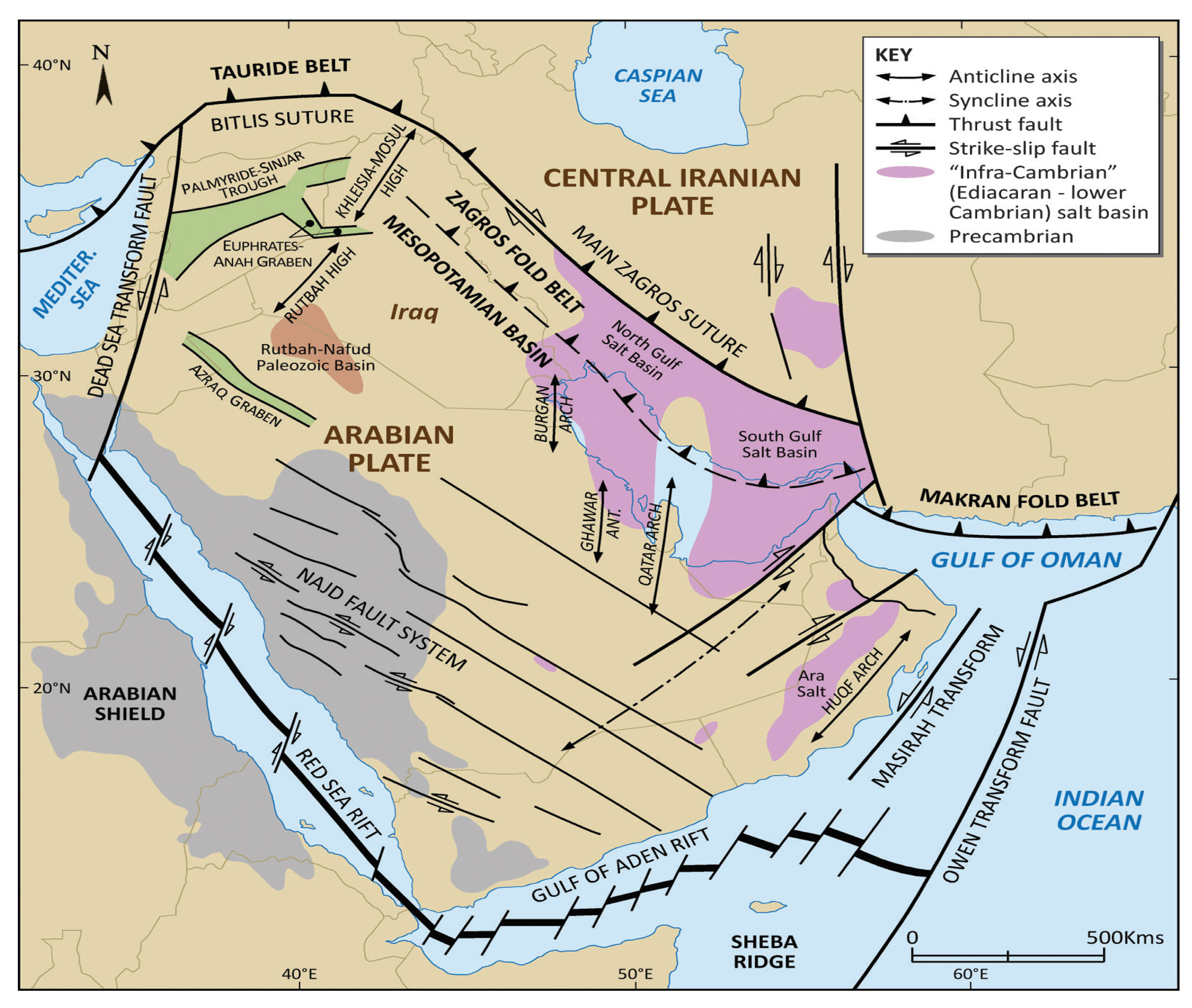
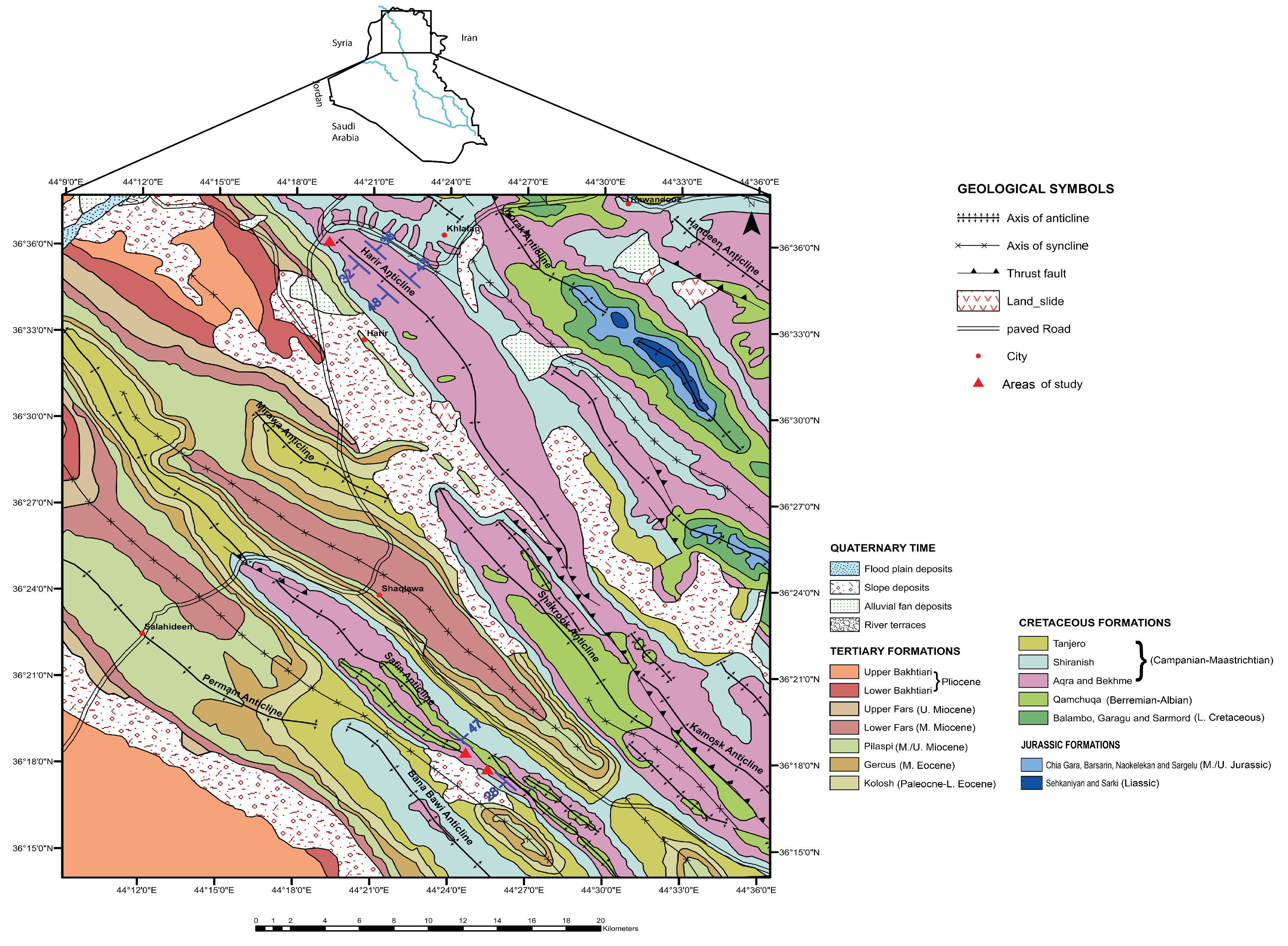





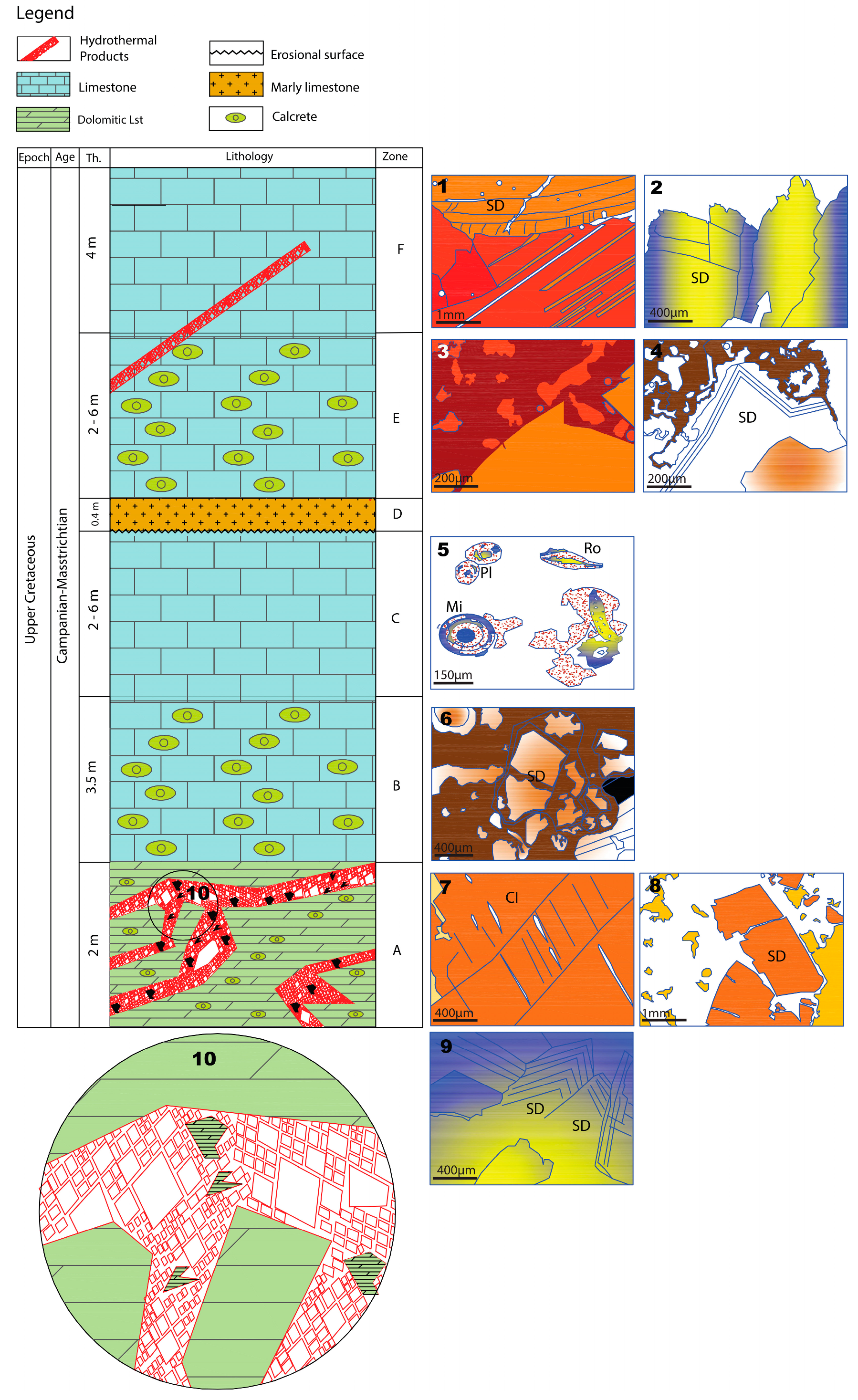
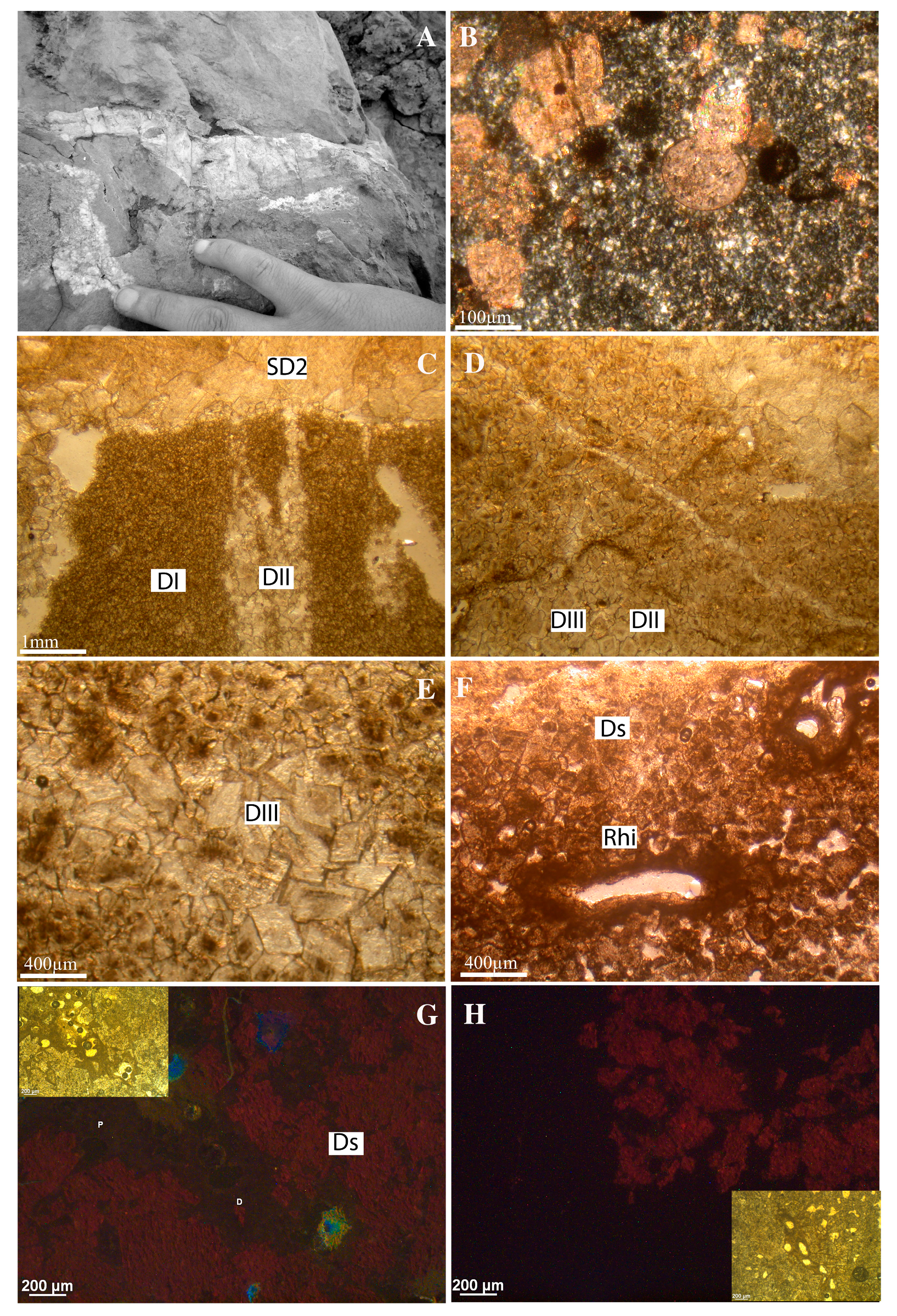
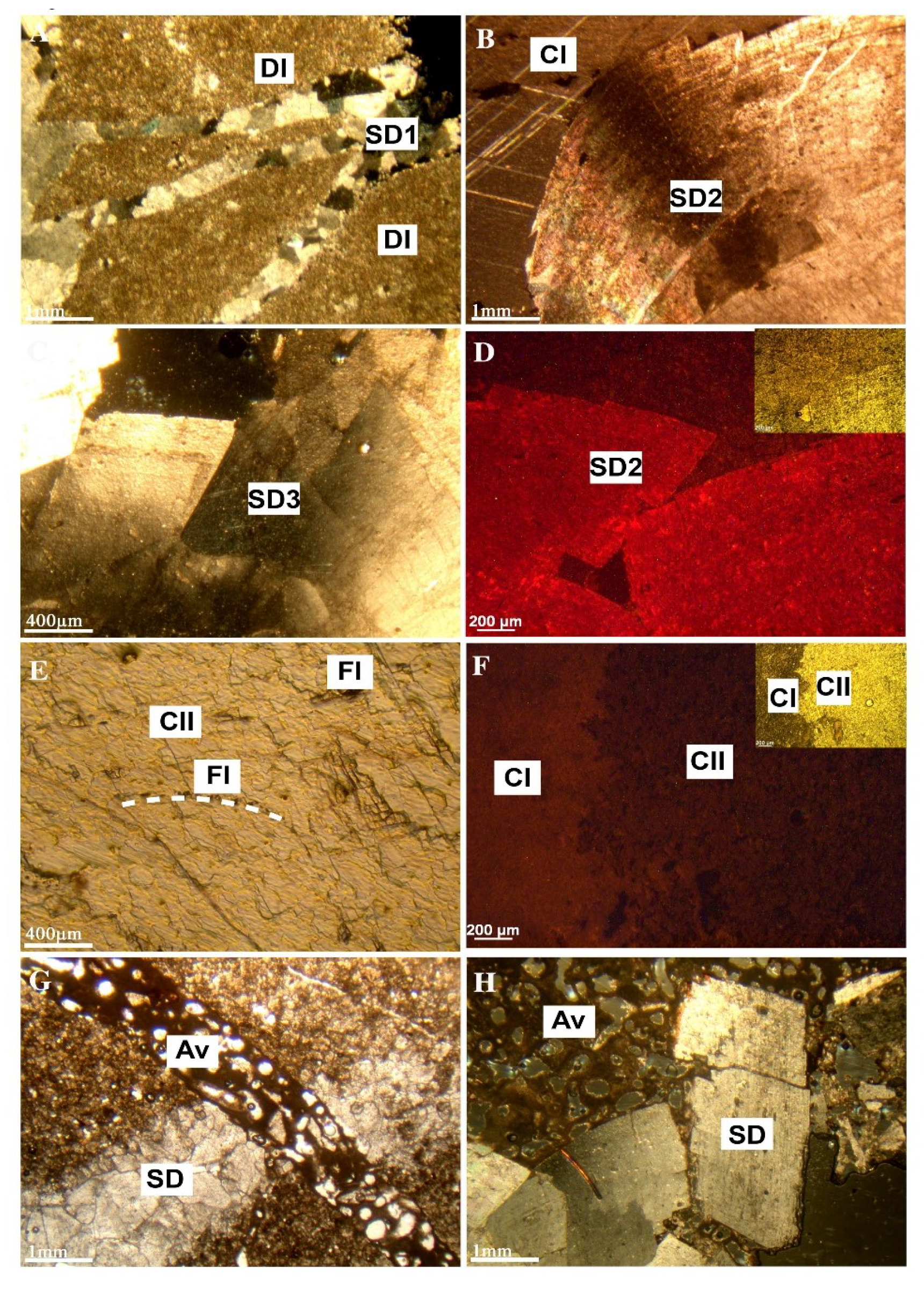
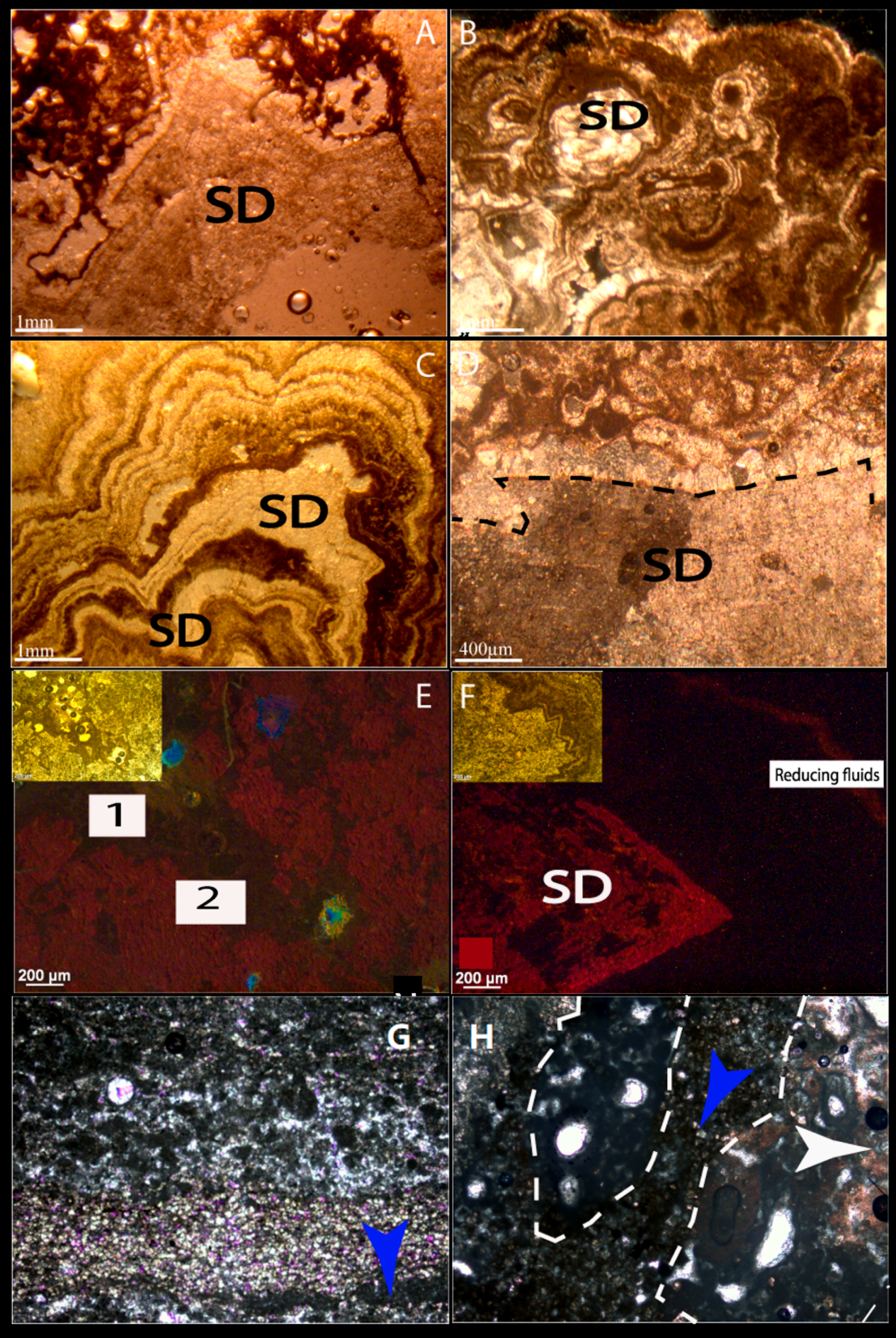




| Sample No. | Phase | δ13C | δ18O |
|---|---|---|---|
| Sp.3 | Cal | −0.61 | −6.78 |
| Sp.3 | Chert nodules | 0.68 | −6.96 |
| SP.5 | Cal | −9.56 | −7.34 |
| SP.8 | Cal | −5.4 | −7.05 |
| SP.11 | Cal | −0.12 | −6.66 |
| SP12 | Chert nodules | 0.64 | −6.78 |
| SP13 | Cal | 2.45 | −6.55 |
| SP.3 | Cal | −1.34 | −7.06 |
| Sua.42 | DI | 1.21 | −8.17 |
| SP.5 | Cal | −9.27 | −7.28 |
| Sua.45 | DI | 0.96 | −6.88 |
| Sua.43 | Cal | 0.96 | −5.07 |
| SP.6 | CI | −3.36 | −18.98 |
| SP.31 | Cal | −1.98 | −6.73 |
| SP.16 | Cal | 1.69 | −6.88 |
| SP.8 | Cal | −7.81 | −7.33 |
| SP.4 | SD1 Calcretized | 1.46 | −6.33 |
| SP.30 | Cal | 0.25 | −17.8 |
| Sua.46 | TD | 1.28 | −6.91 |
| Sua.47 | TD | 1.32 | −6.86 |
| Sua.48 | TD | 0.75 | −6.88 |
| Sua.49 | TD | −1.72 | −6.84 |
| Sua.50 | TD | 1.1 | −6.77 |
| Sua.51 | TD | −3.98 | −6.45 |
| Sua.52 | TD | −8.62 | −6.97 |
| Sua.53 | TD | −7.34 | −8.06 |
| Sua.54 | TD | −7.5 | −7.71 |
| Sua.55 | TD | 1.73 | −6.77 |
| SP.29 | TD | 1.65 | −6.88 |
| Sua.56 | TD | −4.44 | −6.94 |
© 2019 by the authors. Licensee MDPI, Basel, Switzerland. This article is an open access article distributed under the terms and conditions of the Creative Commons Attribution (CC BY) license (http://creativecommons.org/licenses/by/4.0/).
Share and Cite
Salih, N.; Mansurbeg, H.; Kolo, K.; Préat, A. Hydrothermal Carbonate Mineralization, Calcretization, and Microbial Diagenesis Associated with Multiple Sedimentary Phases in the Upper Cretaceous Bekhme Formation, Kurdistan Region-Iraq. Geosciences 2019, 9, 459. https://doi.org/10.3390/geosciences9110459
Salih N, Mansurbeg H, Kolo K, Préat A. Hydrothermal Carbonate Mineralization, Calcretization, and Microbial Diagenesis Associated with Multiple Sedimentary Phases in the Upper Cretaceous Bekhme Formation, Kurdistan Region-Iraq. Geosciences. 2019; 9(11):459. https://doi.org/10.3390/geosciences9110459
Chicago/Turabian StyleSalih, Namam, Howri Mansurbeg, Kamal Kolo, and Alain Préat. 2019. "Hydrothermal Carbonate Mineralization, Calcretization, and Microbial Diagenesis Associated with Multiple Sedimentary Phases in the Upper Cretaceous Bekhme Formation, Kurdistan Region-Iraq" Geosciences 9, no. 11: 459. https://doi.org/10.3390/geosciences9110459
APA StyleSalih, N., Mansurbeg, H., Kolo, K., & Préat, A. (2019). Hydrothermal Carbonate Mineralization, Calcretization, and Microbial Diagenesis Associated with Multiple Sedimentary Phases in the Upper Cretaceous Bekhme Formation, Kurdistan Region-Iraq. Geosciences, 9(11), 459. https://doi.org/10.3390/geosciences9110459






